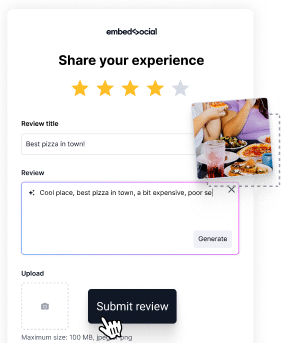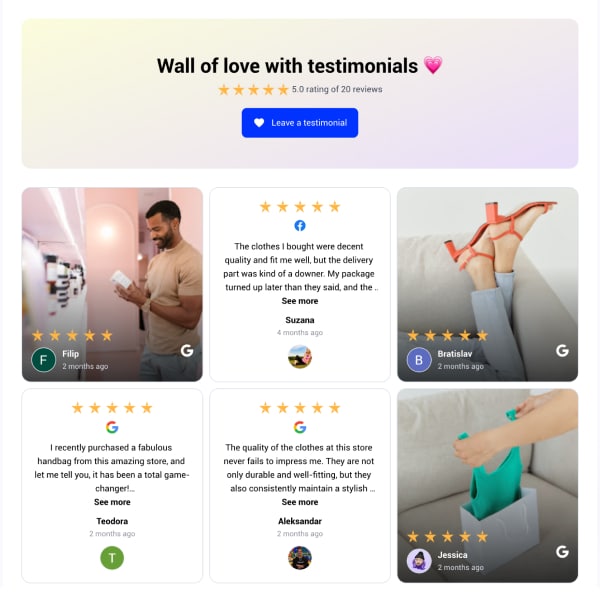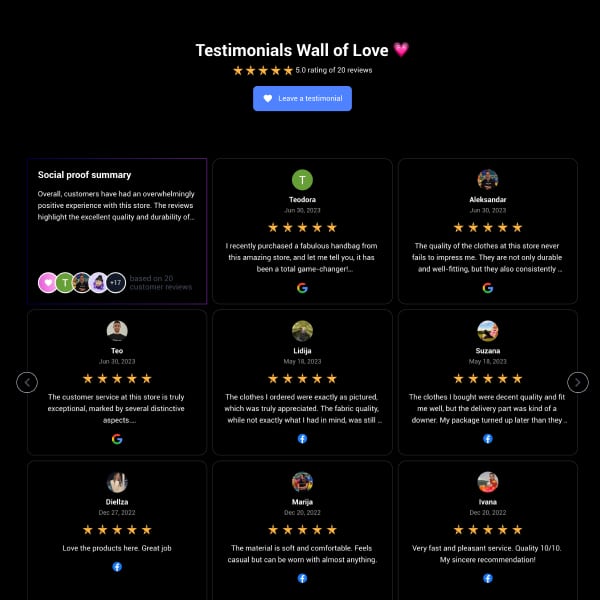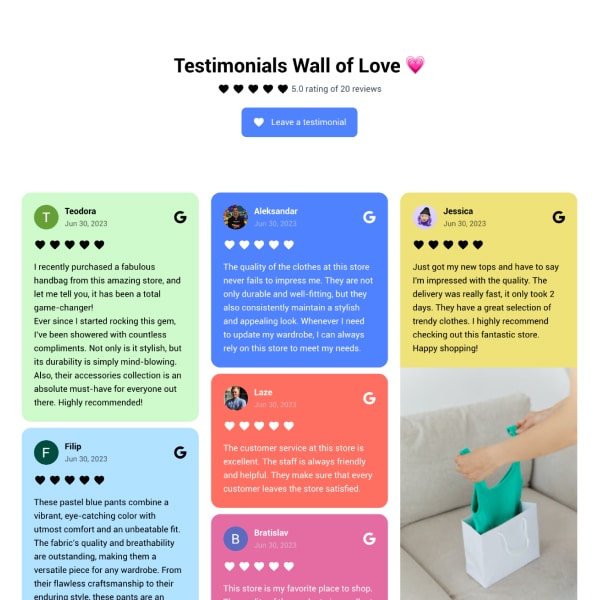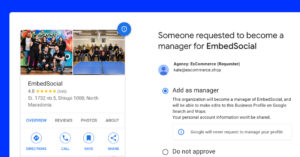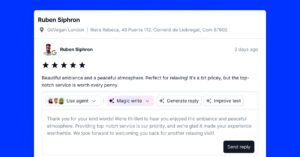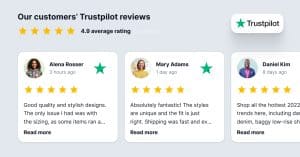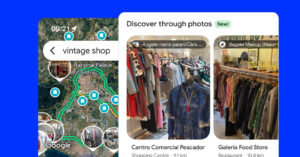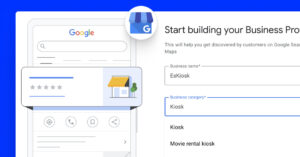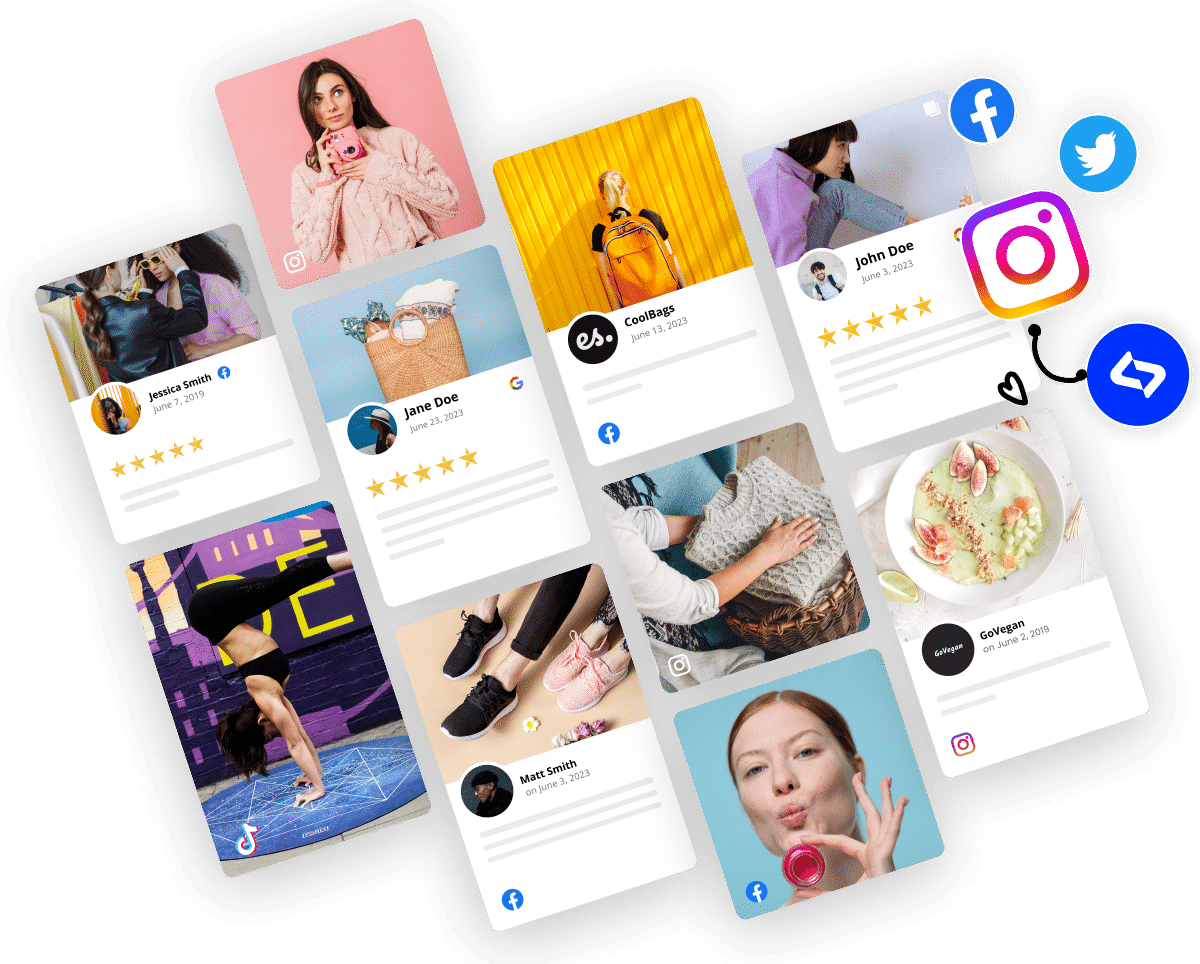One of the most important factors in business growth is customer satisfaction, as it provides heaps of benefits, from improving brand trust and exposure to driving increased organic traffic and providing feedback about your services—all of which ultimately drive more sales.
The best medium to convey that satisfaction is the client testimonial page since it’s essentially free praise of your offerings and a powerful marketing and sales tool.
So, if you’ve ever wanted to learn about collecting, displaying, and analyzing offline and online reviews and testimonials, keep reading below!
How to collect testimonials for free?
To start collecting reviews with the EmbedReviews platform, first, you need to create a free account, after which you have to log in and follow these steps:
- Navigate to Collect form in. the main menu;
- Customize the form for your needs. Select the required fields;
- Paid users can activate an AI reviews assistant to collect more textual testimonials.
- Once done customizing, go to Code and copy the form URL
See the steps below:
You can use the URL of this form and also send it to your customers via email so they can directly submit their reviews and testimonials.
You can also choose to include this form in all your widgets ‘and add a ‘leave a review’ button that will link to the custom reviews collector form.
All the testimonials and reviews you receive will be recorded in the Sources > Collect form source.
Next, you can create a widget with this Collect form source and actually display the collected reviews on your website:
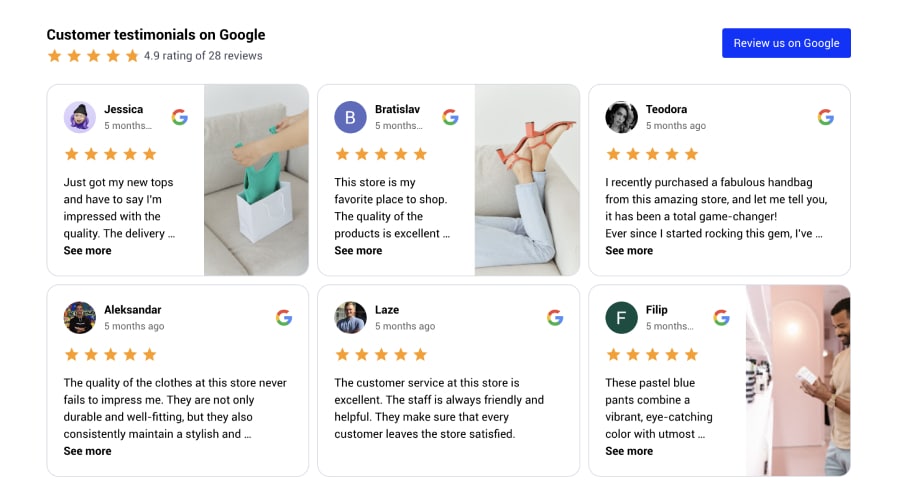
For more detailed information, check our blog post below that outlines several main methods for testimonial collection, as detailed below.
Related blog post
What is a customer testimonial?
Testimonials are typically written or spoken statements that praise and recommend the quality of a product or service, often based on personal experience or satisfaction.
As such, they are the best type of social proof anywhere, so they are effectively used as endorsements in advertising, sales pages, and marketing material with great success.
Testimonials vs. Reviews
Before going any further, let’s note the differences between testimonials and reviews:
Origin
- Testimonials: Usually solicited or selected by the company or individual being praised.
- Reviews: These can be unsolicited and are generated by customers or users, often on third-party platforms.
Content
- Testimonials: Typically positive, highlighting the strengths or benefits of a product, service, or individual.
- Reviews: Can be either positive or negative, offering a more comprehensive view of a user’s experience.
Purpose
- Testimonials: Primarily used for promotional purposes to build trust and credibility in companies.
- Reviews: Provide potential customers with unbiased feedback about consumer products.
Control and Presentation
- Testimonials: Generally controlled by the company, allowing them to choose which testimonials to publish and where to feature them, thus usually highlighting the positive aspects of the product or service.
- Reviews: Often found on independent platforms, offering a more unfiltered and broad spectrum of customer opinions, including praise and criticism for a well-rounded view of user experiences.
Note: While there’s a distinction between both terms, marketing professionals still use testimonials and glowing reviews almost interchangeably since they usually serve the same purpose: to show off the brand’s strengths as presented by unaffiliated third parties.
What types of testimonials are there?
Understanding the various types of text and video testimonials used can help businesses strategize their marketing efforts more effectively:
Quote Testimonials
These are short and direct statements, usually written or video testimonials, where customers or clients praise the product or service, often featured on websites or marketing materials.
Video Testimonials
These are testimonials captured on video, often portraying customers sharing their positive experiences with a product or service more personally and engagingly. You should always collect video testimonials and embed them on your website through one of the many testimonial software tools.
Influencer Testimonials
These involve social media influencers or bloggers promoting a product or service to their audience, leveraging social media channels and their reach and influence to vouch for the product’s quality or effectiveness.
Social Testimonials
These are positive feedbacks or endorsements shared on social media platforms by users. They may be unsolicited and often come in the form of positive comments, shares, or likes, showcasing real people’s approval or satisfaction with a product or service.
Interview Testimonials
These are detailed testimonials that come from interviews with satisfied customers, where they discuss their experiences in-depth, offering potential customers a detailed insight into the benefits of the product or service.
Case Study Testimonials
These in-depth analyses detail how a product or service helped a customer or a company solve a problem or achieve a goal, typically backed by data and results.
Peer Testimonials
These testimonials come from individuals who share similar characteristics or demographics with the potential customer, creating a relatable context and indicating that individuals “like them” have had positive experiences with the product or service.
Related:
How do we collect testimonials? 7 Best practices
There are several methods to collect more testimonials from clients. Check them out below!
1. Use a review collection platform
The best approach to obtaining customer opinions is using a testimonial management platform like EmberReviews since it can access and pull data from all popular social review sites.
For example, with EmbedReveiws, you can connect your Google My Business profile and collect your Google reviews or Facebook page to get your Facebook testimonials.
EmbedReviews also connects to third-party review sites such as Trustpilot, Yelp, Airbnb, and similar, allowing you to import and/or create custom review sources.
2. Embed a feedback form widget
As mentioned, you can use a forms builder to design the right feedback form for your business and embed it as a widget on your website. EmbedForms allows you to create and embed engaging web forms as widgets on any site. Customers love them because they are fast, efficient, and simple.

3. Request testimonials via email
EmbedReviews also allows users to send out testimonial form request emails to one or more customers containing a link to a testimonial request form that can be filled out anytime. Reminders, email notifications, and photo prompts are some of the included features.
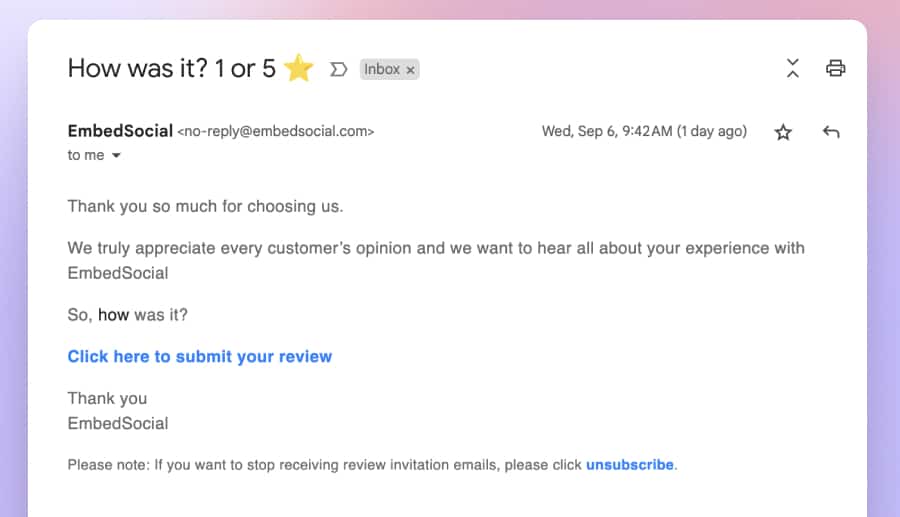
4. Collect testimonials via SMS
Businesses with clients’ phone numbers can import them into EmbedReviews and request testimonials via SMS. This can be very effective since customers are redirected to a mobile-friendly testimonial form where they only need to add a star rating and leave their thoughts.
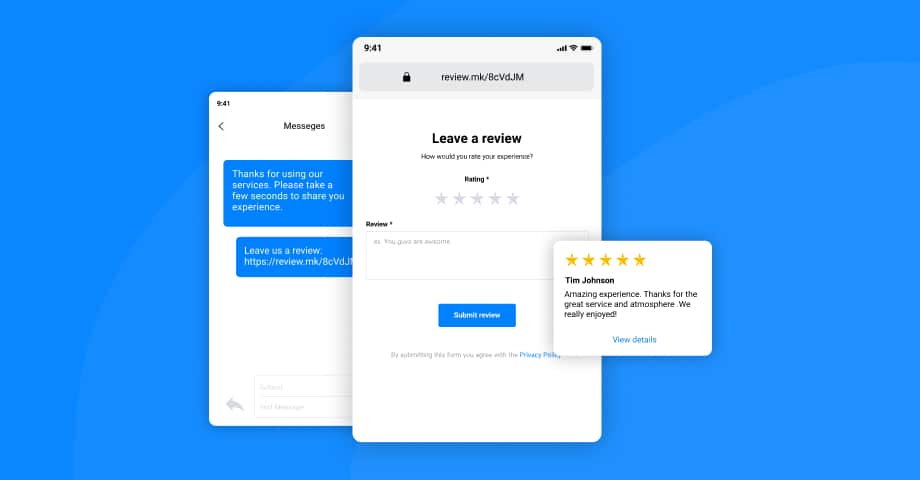
5. Get testimonials on eCommerce platforms
If you are using an e-commerce platform like Shopify, you can collect reviews by setting up an automated email to be sent out each time a new customer buys a product.
For that purpose, you can use EmbedSocial’s Verified Reviews app, which, once installed, automatically collects and syncs reviews before displaying them on the relevant product page.
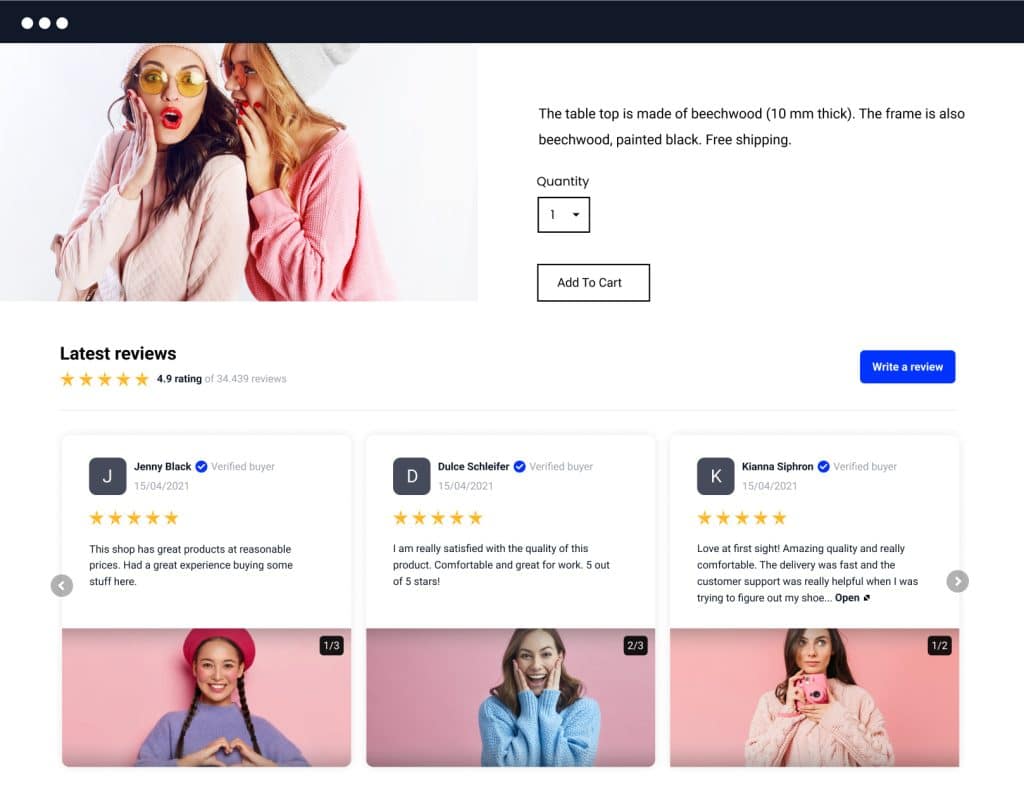
6. Obtain and upload your reviews manually
Of course, you can obtain testimonials from different platforms and export them as CSV or XLS files. Then, you have to upload them manually using a single platform. For instance, EmbedReviews offers a manual upload option that allows you to bring in every good review you find online.

7. Ask for video testimonials
Sometimes, collecting a video testimonial is easier and more effective than we think, especially if you have a dedicated sales rep who talks with your customers daily and can ask them to say a few words about their experiences with your products and services.
Related:
8. Get testimonials via NFC cards
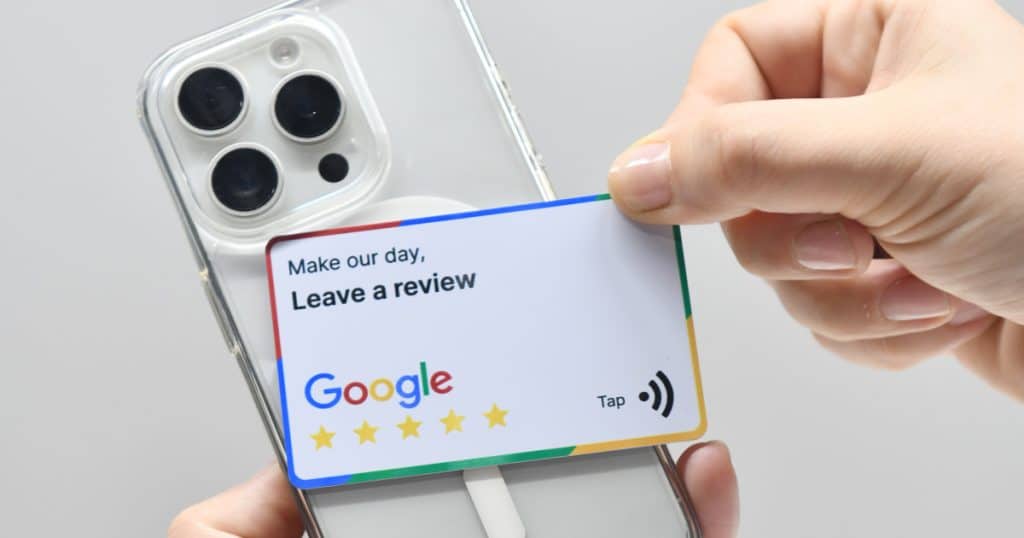
Digital NFC cards are the latest trend of owning a business card. These are usually plastic cards that, when tapped on an NFC (Near Field Communication) enabled phone, can link to a page where people can leave their testimonials.
For example, the Google reviews NFC card when tapped, redirects the customer to the Google review link where he can write a Google review directly on the Google location of the business.
How do you actually ask for testimonials? + Questions
We mentioned the methods to ask for testimonials above, but here, we will share what actually to say or write when requesting testimonials. Here is a checklist that will help you ask for a testimonial:
Ask to swap testimonials
If you’ve collaborated with other businesses or professionals and both parties are satisfied with the partnership, consider swapping glowing testimonials. This is a win-win situation where both parties benefit from positive feedback.
Example: “We’ve had a great experience working together. Would you be interested in exchanging testimonials for our respective websites?”
Support your ask with a compliment
When reaching out to ask for a testimonial, start by complimenting the client or expressing gratitude for their business. This sets a positive tone and makes the request feel less transactional.
Example: “We’ve truly enjoyed working with you and are proud of the results we achieved together. Would you be willing to share a testimonial about your experience?”
Be genuine and thankful
One of the easiest ways how to get testimonials from clients is with a genuine appreciation for the client’s time and feedback. Thank them for considering your request, regardless of whether they choose to provide a testimonial.
Example: “Your feedback means the world to us. Whether or not you choose to provide a testimonial, we’re grateful for the opportunity to serve you.”
Testimonial question examples for high-quality responses
Did you make a sale and would like to receive feedback but are unsure how to craft your request? You can always get started by utilizing question testimonial templates like these:
Experience-Based Testimonial Questions:
- What was your primary concern about purchasing our product/service?
- Can you describe a specific experience with us that stands out?
- How has our product/service changed your day-to-day life or business operations?
Outcome-Based Questions:
- What specific results have you achieved since using our product/service?
- Can you share a measurable outcome or statistic that demonstrates the value you’ve received?
Recommendation-Based Questions:
- How likely are you to recommend our product/service to a colleague or friend? Why?
- If someone was on the fence about using our product/service, what would you say to them?
Visual Testimonial Questions:
- Would you be willing to share a photo or video of you using our product/service?
- Can you provide a before-and-after visual to showcase the impact of our product/service?
Why gather testimonials in the first place?
Collecting client testimonials also offers a myriad of benefits for businesses and professionals:
They build trust and credibility
Testimonials act as social proof that your product or service is reliable and high-quality.
Positive testimonials from real customers can help build trust in local businesses and establish credibility among prospective customers.
They enhance the brand’s reputation
Featuring positive customer testimonials can enhance your brand’s reputation.
When potential customers see a positive testimonial or feedback from satisfied customers, it positively influences their perception of your brand.
They facilitate the decision-making process
Testimonials provide the reassurance needed to proceed with the purchase.
Praiseful testimonials help potential buyers by facilitating decision-making with real-world positive experiences from existing customers.
They increase the conversion rates
Testimonials displayed in your marketing materials (or website) increase conversion rates.
They are persuasive tools that convince potential and current customers of the value and effectiveness of your product or service, encouraging them to purchase or sign up for a service.
They provide valuable feedback
Collecting testimonials can also offer valuable feedback about your products or services.
Positive client testimonials can highlight the strengths of your offerings, while constructive feedback can help you identify areas for improvement.
They boost the SEO strategy
They can effectively boost your SEO strategy and local search listings.
Your testimonials page’s fresh and original content can improve your website’s search engine rankings, thus helping drive more organic traffic.
Do more by displaying your testimonials
Once you get those amazing testimonials, you must display them on your website or across your social media pages. Here are some ways where you can showcase everything you collect.
Display testimonials on your website
Once you’ve generated the testimonials page, you can use your free EmbedReviews account and display the reviews on your Facebook business page or any website.
To do this, follow the steps below:
- Step 1: Go to Widgets and click ‘New widget.’
- Step 2: Choose the source for your reviews and click ‘Create widget.’
- Step 3: You will be transferred to the editor, where you can fully customize the testimonial widget.
- Step 4: Paste the code to your website’s HTML body section.
That’s it.
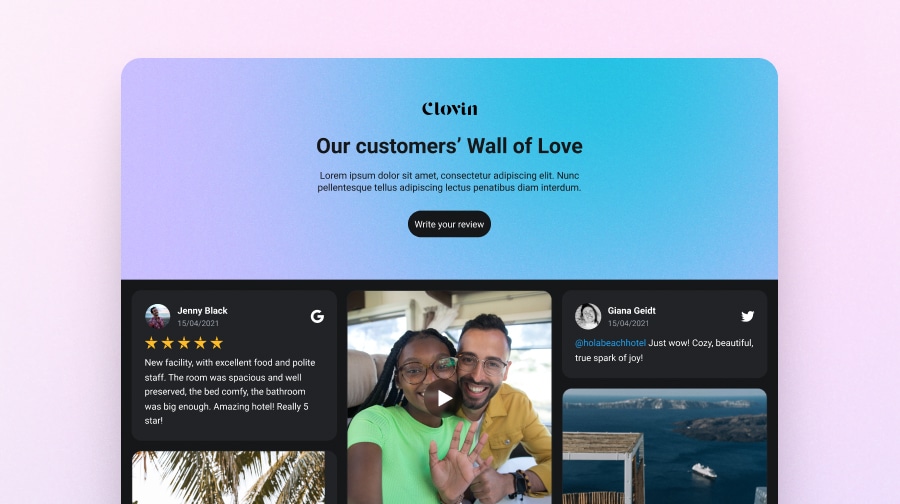
You will build an effective testimonial page with all your testimonials in one place in just a few clicks. Here is a full video of how you can use the Forever Free Reviews widget to collect customer reviews on your website and display these reviews on landing pages on your website:
Want to check out how popular brands integrate testimonials on their websites? Check out these:
Turning customer testimonials into Facebook ads
One of the best uses of the testimonials you collect is to add them to your new advertisements. That way, you’ll get them in front of as many potential clients as possible.
EmbedReviews offers a fantastic feature that allows users to use their pre-generated reviews and create a Facebook ad with a couple of button clicks on a single page.
Please note that payments are processed through your Facebook Ad accounts, meaning our system takes no commission for the ads you create.
Related:
Showing off customer testimonials offline
Did you know you can use your customer reviews as social proof outside the Internet?
It’s not that hard to do since there are many ways to exhibit the praise you receive. Here are several of the most creative and effective ways to leverage customer testimonials in the offline realm:
- Printed Material:
- Brochures & Flyers: Incorporate testimonials in brochures, flyers, and other printed marketing materials distributed at events, stores, or through mail.
- Business Cards: Feature a short and impactful testimonial on the back of your business cards. You can also use a digital version, like Uniqode’s business card, to include a scannable QR code that links directly to a full testimonial page or review form.
- In-Store Displays:
- Posters & Banners: Design eye-catching posters and banners featuring customer testimonials and place them strategically around your store or office.
- Product Packaging: Print testimonials on product packaging to build trust and influence purchasing decisions.
- Events & Trade Shows:
- Booth Design: Integrate testimonials into your booth design at trade shows and exhibitions.
- Presentations: Highlight customer reviews during presentations and speeches to add credibility.
- Direct Mail Campaigns:
- Postcards & Letters: Send personalized direct mail pieces featuring testimonials to target customers or prospects.
- Newsletters: Include a section dedicated to customer feedback in your company’s printed newsletters.
- Point of Sale:
- Receipts & Invoices: Print short testimonials on the bottom of receipts or invoices.
- Checkout Counter: Display testimonials near the checkout counter to reinforce positive experiences.
- Employee Advocacy:
- Training: Educate employees on key testimonials so they can share them during customer interactions.
- Testimonial Booklet: Create a booklet of testimonials for sales representatives to share with potential clients.
- Press Releases & Media:
- Press Kits: Include testimonials in press kits sent to media outlets.
- Media Interviews: Mention customer testimonials during interviews with newspapers, magazines, radio, or TV.
- Community Outreach:
- Local Sponsorships: Feature testimonials in materials related to local sponsorships or community events.
- Community Boards: Post testimonials on community bulletin boards in local centers, libraries, or schools.
As you can see, integrating customer feedback into offline channels can be easily done and will ultimately complement your online marketing strategy at an insignificant cost.
How do you analyze customer testimonials?
Analyzing customer testimonials is about gaining insights, identifying trends, and improving your products, services, and customer experiences. In general, you’ll have to complete any or all of these steps to analyze the reviews you receive from clients thoroughly:
- Categorize feedback:
- Sort testimonials into categories based on themes, products, services, or features mentioned.
- Identify common praises or concerns raised by customers.
- Sentiment analysis:
- Use sentiment analysis tools to determine the overall tone of the testimonials (positive, negative, neutral).
- Identify specific words or phrases that are frequently associated with positive or negative sentiments.
- Identify trends and patterns:
- Look for recurring themes or patterns in the feedback.
- Analyze the frequency of specific praises or concerns to identify areas of strength and improvement.
- Measure impact:
- Assess the impact of testimonials on key performance indicators (KPIs) such as conversion rates, customer retention, and brand reputation.
- Track changes in customer behavior or engagement following the publication of testimonials.
- Customer segmentation:
- Segment testimonials based on customer demographics, purchase history, or behavior.
- Analyze feedback from different customer segments to tailor products, services, or marketing strategies.
- Competitor comparison:
- Compare your testimonials with those of competitors to identify unique selling points (USPs) or areas where competitors may have an edge.
- Adjust strategies based on competitive insights.
- Actionable insights:
- Translate the analysis into actionable insights for improving products, services, customer experience, or marketing strategies.
- Prioritize areas for improvement based on the significance and frequency of feedback.
- Monitor progress:
- Continuously monitor new testimonials and feedback to track progress and identify emerging trends or issues.
- Adjust strategies and actions based on ongoing analysis.
Businesses can gain valuable insights, enhance customer satisfaction, and make informed decisions to drive growth and success by systematically analyzing customer reviews.
Getting Started with Testimonial Examples on a Website
The ability to show and receive testimonials on your website is made easy by using testimonials widgets. Below are few examples of widgets that you can browse and pick to get started.
Conclusion
Understanding how to collect, utilize, and analyze testimonials is vital to bolstering a business’s reputation and fostering growth, and once you get praise, you must display it as soon as possible, which you can and must do both online and offline.
Whether you’re amplifying your brand’s voice on social media, enhancing your SEO strategy, or turning positive feedback into compelling ads, you must remember that the authentic voice of your satisfied and loyal customers is your most powerful marketing tool.
